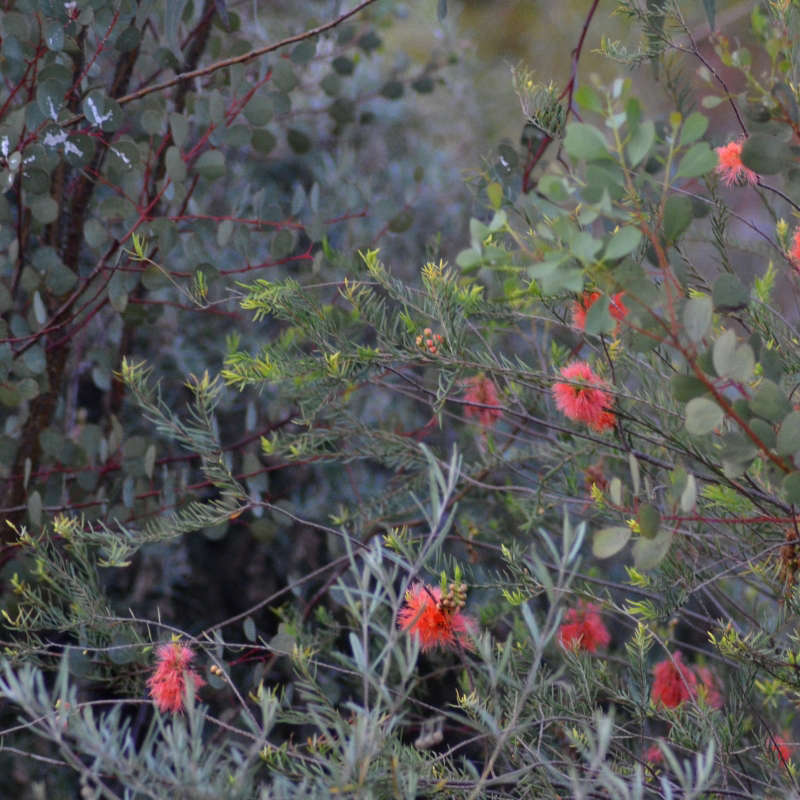While I have never visited Australia (yet), I use plants from there so often in my garden designs in the Bay Area that I almost feel like I have. But of course, my knowledge is only so deep, given I’ve never stepped a foot inside the country, so for this story, I reached out to Troy McGregor, founder and nurseryman of Waltzing Matilija, an online nursery for Australian and South African plants adapted to dry climates.
Troy tells me that there are more members of the Protea family in Australia (800-ish) than there are in South Africa (300-ish). I asked him for common mistakes that gardeners make when planting and growing proteacea plants: “Drainage and fertilizer are the two biggest hurdles gardeners get tripped up on. With exceptions, these plants come from ancient (acidic) soils, deprived of nutrients, that drain well. To replicate this we need to berm up and over the clay soils most of us have.” Troy also emphasized that Australian plants generally don’t need fertilizer once planted; occasionally micro-nutrients can be helpful with yellowing or chlorosis, but if the drainage and pH (6-6.5) is taken care of, then they’re not necessary. And cool fact: The tasty macadamia nut is actually indigenous to Australia, even though many people think it originates from Hawaii.
I also asked Troy to collaborate on this list of favorite Aussie flowers. Read on for our picks.
Grevillea ‘Superb’

Troy and I both agree on this stellar shrub making the list. Expect non-stop, nectar-rich flowers all summer. I have this plant in my Bay Area garden and it blooms year-round, which thrills the local hummingbirds. Also, this evergreen shrub requires very little care and makes an excellent unique presence in a drought-tolerant garden. Troy shares, “As with most Grevilleas with G. banksii as a parent, prune in the spring to promote a better form and more flowers.” Grows to 3-4′ tall by 4-6′ wide and favors well-draining soil and a sunny spot. Hardy to around 27°F. To learn more about Grevilleas, please visit: Gardening 101: Grevilleas.
Xerochrysum bracteatum

Its easier to pronounce common name, “strawflower,” describes this short-lived perennial. Try growing this amazing cut flower from seed, in a very sunny spot with soil that drains well. Definitely deadhead the flowers to promote continued bloom—which shouldn’t be hard because you’ll want to add them to arrangements and bouquets. Hardy in USDA Zones 8-11; an annual in colder regions. To learn more, please visit: Gardening 101: Strawflower.
Callistemon ‘Cane’s Hybrid’

Better known as Cane’s bottlebrush, this pinkalicious bee favorite grows to a stately 12-20′ tall by 10-15′ wide and blooms in the summer. Works lovely as a screen, hedge, or backdrop. Bottlebrush can take heat, deer invaders, and coastal windy conditions—plus some aggressive punning. Hardy to 15-20°F.
Eucalyptus macrocarpa

While some may say this large (6-8′ tall) shrub is lanky and a bit wonky-looking, the flowers are really show-stoppers. Oversized gold-tipped red flowers burst into action in the summer and contrast beautifully against the powder-white leaves. Consider using the woody fruits for crafts or floral design. Plant in a sunny spot with fast-draining soil, and give it room to come into its own unique shape. Cold hardy to about 27°F.
Isopogon formosus

Troy and I both agree this shrub, also known as “drumsticks,” is the easiest member of the genus that is adaptable to most gardens. In late winter into spring, you can expect dozens of pink pom-poms adorning the stems that sway about in the breeze and last for weeks as a cut flower. Well-draining soil is key and full sun is best. Grows to 4-6′ tall and 3-4′ wide, so place this beauty in the back of a border. Hardy to around 26°F.
Grevillea ‘Fanfare’

Literally blooming spring to fall, this relatively fast-growing ground cover (only reaching 1′ high) really lives up to that task because it seriously covers some ground. Consider this your problem solving plant if you have 12-15 sq ft to cover and you only want one low water plant, or you want to obscure an ugly retaining wall with some nectar-rich razzle dazzle blooms that cascade. Hardy to 25 degrees F.
Craspedia sp.

Oh, how I love Billy buttons. Golden yellow globes stand proud on delicate thin stems, ultimately growing to 2′ tall. Cut, they last for a long time in a vase. Either grow your buttons from nursery starts (if you can find them) or, simpler, from seed. These plants like sun and moderate amounts of water. Hardy in USDA Zones 9-12. To learn more, please visit: Gardening 101: Billy Buttons.
Anigozanthos sp.

Real crowd-pleasers and one of my favorites, Kangaroo paws come in so many different colors—bright red, burgundy, yellow, pink, orange, even pale green. Kangaroo paws also come in varying sizes, so read labels before purchasing. The flowers aren’t tasty to deer but attract birds and hummingbirds like crazy and make unique cut flowers. Well-draining soil and a sunny to mostly sunny spot is preferred for best growth. Pro tip: cut back your paws to within about 3 inches to the ground in late winter, making sure to remove diseased and frost-damaged leaves (this reduces the chance that harbored pests and diseases persist). To learn more, visit: Gardening 101: Kangaroo Paw.
See also:
- 10 Garden Ideas to Steal from Australia
- Before & After: A Two-Faced Victorian Garden with a Secret
- 10 Favorites: Stalwart Plants that Thrive in Hot Gardens







Have a Question or Comment About This Post?
Join the conversation